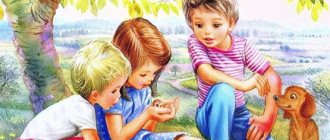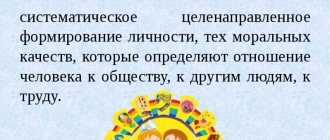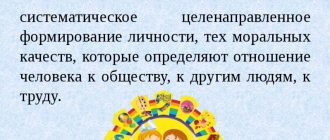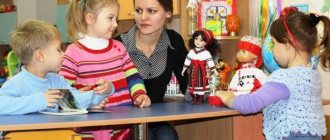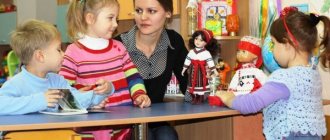Project “Spiritual and moral education in preschool educational institutions through fairy tales”
2. Productive activity - sculpting animals - heroes of a fairy tale.
3. Visual information for parents “The role of fairy tales in the spiritual and moral education of children.”
Tuesday
“Where friendship is strong, things go well”
1. Productive activity - designing a house for animals.
2. Reading proverbs and sayings about friendship and harmony.
3. Didactic game “Say the opposite”. Goal: to develop the ability to choose words (good - evil, agreement - hostility, hard work - lies, etc.)
4. Conversation “A tree is held together by its roots, and a person is held together by friends.”
Wednesday
"A friend in need is a friend indeed
1. Reading fairy tales about friendship, mutual assistance, and harmony (“The Bean Seed,” “Zayushkina’s Toy,” “The Cat, the Rooster and the Fox”).
2. Productive activity - drawing “Winter quarters of animals”.
3. D/i “Correct the mistake.” Goal: to develop the ability to reconstruct events sequentially from pictures.
4. Conversation with parents about the importance of joint reading of fairy tales and other works for the formation of spiritual and moral qualities.
Thursday
“We are all together all day long and we are not too lazy to work.”
1. Conversation “We are all together all day long and we are not too lazy to work.”
2. Listening to songs about friendship (“When my friends are with me”, “Song of Leopold the cat”).
3. Productive activity - unconventional drawing “Tree of Friendship” (blotography).
The final stage.
Friday
1. The story of the fairy tale “Winter quarters of animals” using colorful illustrations.
2. Exhibition of children's works.
3. Entertainment - quiz “Find out a fairy tale.”
Conclusions.
The results of the project were:
— increasing the level of development of communication skills in children;
- developing in children the need to communicate with each other, mutual assistance, support, as well as joint activities.
Prospects for further work:
— continue to develop skills of interaction, cooperation, a sense of friendship, collectivism;
- introduce various ways to overcome conflict situations, using works of Russian folk art, the concepts of “friendship, friends.”
References:
1. Veraksy N. E., Komarova T. S., Vasilyeva M. A. Program “From birth to school.” Ed. Moscow “MOSAIC SYNTHESIS”, 2014.
2. Glebova S. V. “Kindergarten - family: aspect of interaction.” Ed. Voronezh, shopping center "Teacher", 2005.
3. We introduce literature to children 3-4 years old. Ed. "Sphere", Moscow, 2010.
4. Compiled by Yudaeva M.V. Reading book. 2nd junior group. Ed. Moscow “Samovar”, 2015.
5. Ushakova O. S. “Speech development of children 3-5 years old.” Ed. "Sphere" Moscow, 2011.
Annex 1
Municipal budgetary preschool educational institution "General developmental kindergarten No. 34" of the Nizhnekamsk municipal district of the Republic of Tatarstan
Personal example - its role in moral education
As we wrote above, children cannot be taught morality; they can only learn it from adults. Adults are an example for preschool age. Especially the example of parents. Parents are ideal for the baby . Everything they do is right and good for him by default. If a mother raises her hand to a child, and a father resolves conflicts with his fists (or worse, hits the mother), then they can tell him as much as they want that fighting is not good, but he has already taken the model of behavior from his parents, and for him it is the only correct one .
How to teach a child to count - effective and proven methods
For children, sources of moral education are:
- Parents;
- The adults around him (caregivers, teachers, relatives, older brothers and sisters);
- Fairy tales (especially folk tales, and not only Russian ones);
- TV and Internet;
- Environment.
Attention
Recognizing someone as an authority, the child consciously (and more often subconsciously) copies his behavior, and this, for a second, forms the foundation of his moral image. Therefore, dear parents, educators, and simply elders, be careful about your behavior if you want our future generation to be morally and spiritually educated.
Filtering information, or the important role of television
We will not talk now about the dangers of the TV itself (computer, tablet). Doctors talk a lot about this, but we will remind you of the colossal influence that what a small viewer watches has on moral education. Any seemingly most harmless cartoon carries a semantic load . The beloved hero becomes a role model; his behavior makes adjustments to the upbringing of the preschooler. Therefore, pay attention to what your baby is watching?
In the last century, during that same Soviet era, the state solved this problem for parents with the help of Soyuzmultfilm. Everything that appeared on the screens had an educational purpose. Cartoons taught people to be kind, well-mannered, educated, and hardworking. They taught to love their homeland, love their parents, make friends and respect their elders. And even the “evil” in Soviet cartoons, for the most part, was kindly charming and funny. Do we need to remind you what the level of morality was in the country?
Today the filter and censorship were completely turned off . All kinds of monsters, ugly characters, constantly swearing, shoving, rude, ill-mannered and unkempt, look at the baby from the TV screen.
Important
Notice what information is conveyed by low-quality cartoons from cheap commercial channels?
What children see and what they take in:
- Aggression. An eye for an eye, a tooth for a tooth, and that's putting it mildly. Hit, push, throw something at someone who annoys you;
- Selfishness. Every man for himself in this world;
- Lack of compassion. Laugh if someone is hurt, pass by if someone needs help. Plus the endless pain that the heroes experience. They are beaten, a weight falls on them, they fall from a height, and there are no feelings of regret - children are asked to laugh at an animal that has fallen from a height (example);
- Cunning. To deceive, to deceive in order to achieve a goal;
- Bad manners (how I want to talk about Peppa Pig). Cartoon characters are not shy about the sounds of their bodies (and laugh fervently at this), they climb into the mud and enter without knocking.
Reminders on traffic rules for parents in kindergartens: consultations and meetings
And these characters can become examples of moral culture, just think about it. Cheap videos filled the Internet. Children independently click cartoons on their tablets and computers, while their mothers rush to do household chores. This “information dump” poses a serious danger and damages not only the morality of children, but also their fragile psyche as a whole. Choose only those cartoons that teach goodness and justice - the basis of moral education.
